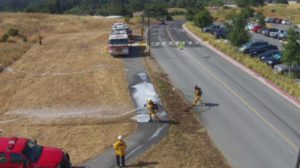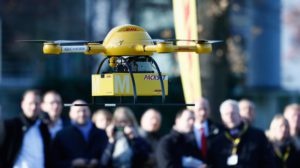It seems everyone is using drones for photography these days! And why not, considering the incredible versatility they offer? Both personal drone use and commercial drone use are up in 2018 and those trends are expected to continue rising. The projected value of the drone industry is expected to exceed $90 billion by 2025. So, how can you improve your drone photography skills?
Here are a few uses for drone photography:
- Fighting California’s worst wildfires
- Getting a first glimpse of a remote Amazon tribe
- Capturing dazzling sporting events
- Detecting chemical and gas leaks
- Inspecting metropolitan canals and water lines
Whether you’re using drones for commercial or hobby photography, there’s more you can be doing to improve the quality of your images or footage. Here are some tips from the CEO of 1UP Aerial Drone Services, Chuck Adams.
Practice, Practice, Practice
Practice makes perfect: Start with the basics like simple take-offs and landings. Then progress to other movements. Work to perform each movement as smoothly as possible and think of those “cinematic moments” in your favorite movie, smoooooooth as silk.
Chuckhighly recommends practicing with the flight simulator for your particular drone. This can save you from expensive crashes while you practice controller inputs and learn to stay oriented at the controls. Hours on the simulator will translate into confidence when you step outside and fire up the real thing.
Practicing applies to your photography as well. Become proficient at capturing basic shots with your drone. Begin with still images from different perspectives. Practice achieving a smooth, level flight while recording video. Experiment with different camera settings in different levels of light to learn what works best. Bring extra batteries as there is never enough time to complete everything you would like to do.
This is Part Art, Part Science
Mastering a drone is part art and part science. You are using an innovative new piece of scientific technology. Science involves research. Familiarize yourself with your owner’s manual. Read up on the latest information and use cases utilizing your particular model of drone. Seek to know everything there is to know about how your drone operates as well as how to control it.
There is more than a bit of artistic flair to controlling a drone well. Artists practice their craft regularly. They also experiment enthusiastically. They are not afraid to push the envelope to see where it can take them. As you become comfortable using your drone, you should seek to push the envelope a little. eek to discover what you can do that is a cut above ordinary.
When talking about using your drone to capture images, think about angles, perspective, and lighting. Drones provide the ability to see things totally new. How can you leverage that into your photography? Combine the artistic view the drone provides with the science of good photography.
Ask, “Is the Subject Interesting?”
Is what you are capturing worth the time and effort? What makes the current image worthy of capture? Look for unique views of ordinary objects. As you become proficient with drone use, you can examine ordinary things from extraordinary angles. Try to capture images of the momentary, the unnoticed, and the exquisite.
Here’s a few tips:
- Look for unique shadow opportunities
- Experiment at different times of the day and night
- Seek to find contrasts
- Look for hard line breaks
- Notice symmetrical objects or patterns
- Discover how the top of things really look
- Simulate speed by flying close to the ground
- Try different length camera lenses
Use Shadows and Different Perspectives
With a drone you can capture extremely high profile shots. You can also capture extremely low profile shots. How does a chipmunk see a park bench? Try shooting images or video very early in the morning or late in the evening to catch the sun at various stages of rise or rest. This can add a beautiful and dramatic effect when coupled with still objects.
Long shadows can be made exceptionally long with drone photography. How could that create an interesting image of your current subject? Create darker images that reek of dread and foreboding by using long shadows to obscure part of the image. Shadow can also be used to highlight different objects or parts of a photo. Spend an entire day in one spot to experience all the various shadow possibilities.
Use the Right Equipment & Software
This is not designed to be an article promoting brands of cameras or accessories. But any article about drone use and photography should talk about equipment and software. High quality cameras with multiple lenses are a plus. Try to acquire some filters to aid with artistic shots.
Even if you’re starting out small, the best camera you can afford should have some standard artistic features like different ISO settings, speed settings, frame settings, and more. Take advantage of the tools you have by using them to their fullest potential. As with any other aspect of drone use and photography, experiment boldly and often to discover new uses and tricks.
Editing software is always a must-have with drone photography. Even if you can take the perfect hover shot, you will still need to clean up extra items in the shot or alter the lighting a bit. Remember to make editing easier on yourself when taking video. Hover a few extra seconds at the beginning and end of every video to allow extra space for editing. It can save you lots of time and headache later. Oh yes; bring extra batteries.
One Final Thought…
Once you’ve acheived the basics dive into the advanced. We can help through our UAV (drone) cinematography specific classes or there are many online classes. Here are some of the more advanced developments you will want to ensure you grasp:
- Deep knowledge of camera settings
- Proper exposure (no, not you and your company….the images!)
- Codecs and file formats
- Style and color settings for outstanding results
- Cinematic shots
- Editing stills and video
How can 1Up Aerial Drone Services help you with personal drone use, commercial drone use, drone imaging, or training? Call us at 720-476-4101 or fill out the contact form on our website for more information.


